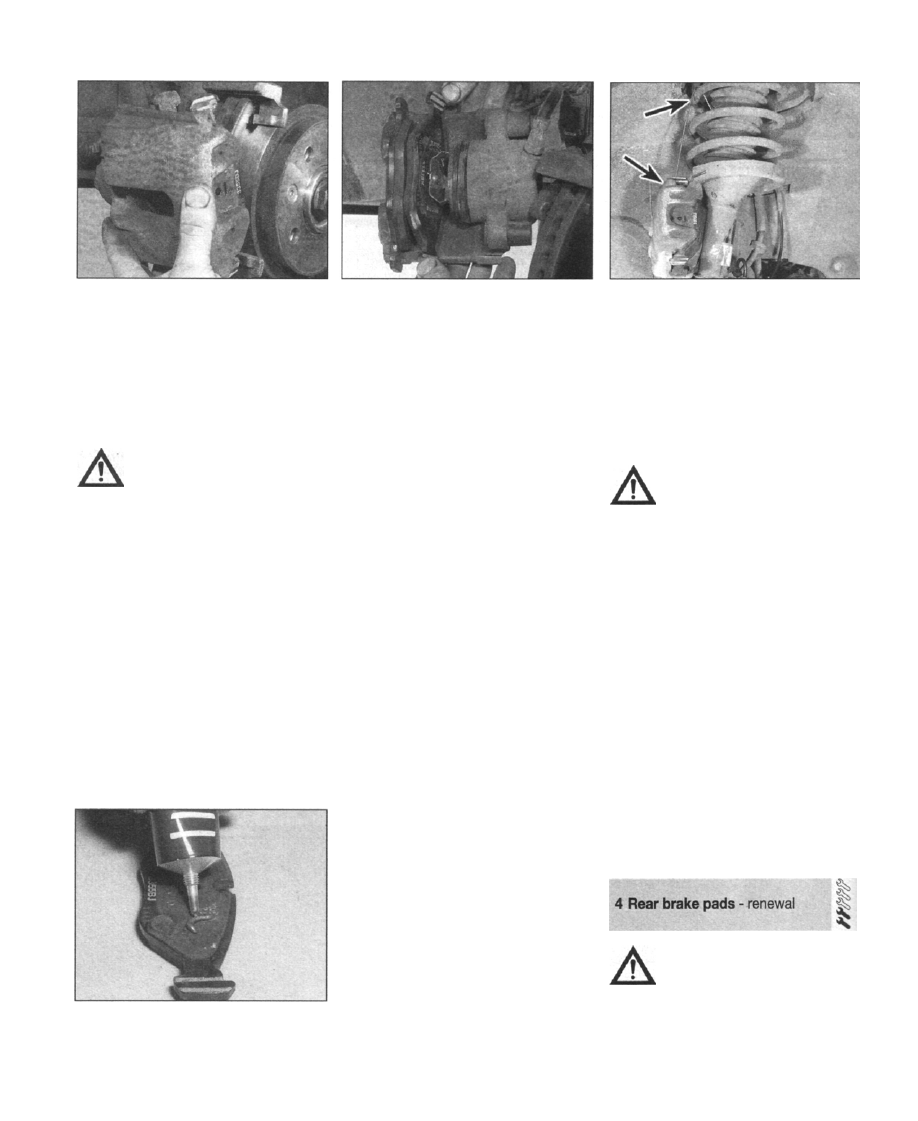SAAB 9000. Manual - part 39

9•6 Braking system
3.10a Take the weight of the hydraulic
body, and lift it away from the carrier
brake pad from the hydraulic body, by prising
the anti-rattle spring attached to its backplate
out of the piston. Lift out the outboard brake
pad (see illustrations).
11 Attach a cable-tie or a length of welding
rod to a part of the hydraulic body casting,
and suspend it from a convenient point on the
suspension (see illustration).
Caution: Do not let the hydraulic
body dangle by the brake hose.
12 Remove the pads from the second caliper
in the same manner.
13 Clear the dust and debris from the caliper
surfaces, using a brush and brake cleaner
fluid. Avoid inhaling the airborne dust.
14 Examine piston seals for signs of leaking
or deterioration, and the piston itself for signs
of wear or damage. With the hydraulic body
removed, check that the guide pins slide freely
in their bores, without excessive play.
Pad inspection - all calipers
15 Measure the depth of the friction material
remaining on each pad. If any of the pads has
worn down below its service limit (see
"Specifications"), then the complete set of four
pads (both roadwheels) must be renewed.
Similarly, if any of the pads has been
contaminated with grease or oil, it is not
possible to clean and re-use it; the whole set
3.16 Apply a small quantity of copper-
based brake grease to the metal backing
plates of the pads; but do not allow any to
come into contact with the friction material
3.1Ob Remove the inboard brake pad from
the hydraulic body by prising the anti-rattle
spring attached to its backplate out of the
piston
must be renewed. If the pads have been
contaminated, identify and rectify the cause
before fitting new pads. If all the pads are still
serviceable, clean them thoroughly using a
brush (ideally, a fine wire brush) and brake
cleaning fluid. Pay particular attention to the
metal backplate, where the pad contacts the
caliper. Examine the surface of the friction
material; carefully prise out any fragments that
have become embedded in it.
16 Apply a small quantity of copper-based
brake grease to the metal backing plates of the
pads; do not allow any to come into contact
with the friction material (see illustration).
17 It is good practice to examine the
condition of the brake discs when inspecting
or renewing the pads; refer to Section 7 for
guidance.
Pad fitting - Girling caliper
18 At the first caliper, slide the pads into
position with the friction material facing the
brake disc.
19 Pivot the caliper hydraulic body down into
position. If the pads bind against the disc,
apply pressure to the inboard pad with a pair
of grips to retract the piston back into the
caliper.
20 Refit and tighten the guide pin retaining
bolt.
21 Fit the brake pads to the second caliper in
the same manner.
22 Depress the brake pedal several times;
this will pressurise the braking system and
bring the pads into contact with the disc. If the
pedal has a developed a spongy feel, air may
have entered the system when the pads were
being removed - refer to Section 2 for
guidance in bleeding the system.
23 Refit the roadwheels, lower the vehicle to
the ground and tighten the bolts to the correct
torque.
24 Top-up level of brake fluid in the reservoir
to the "MAX" mark, and refit the cap.
Pad fitting -ATE caliper
25 Fit the outboard pad to the first caliper by
sliding the backplate locating lugs into the
corresponding grooves in the carrier. Ensure
3.11 Hydraulic body suspended from the
coil spring on a length of wire
that the friction material surface rests squarely
against the disc surface.
26 Fit the inboard pad to the hydraulic body
by pressing the tangs of its anti-rattle spring
into the hollow piston.
27 Using G-clamps or pipe grips, force the
piston and inboard pad back into the hydraulic
body. With the pad retracted, the hydraulic
body can be refitted to the carrier.
Caution: Keep an eye on the level
in the brake fluid reservoir as you
retract the pads, to ensure that
the displaced fluid does not
cause it to overflow.
28 Slacken and remove the G-clamps/grips,
allowing the piston and pads settle in position.
Lightly lubricate the guide pins with a smear of
anti-seize grease and refit them, tightening
them to the correct torque (refer to
Specifications). Refit the dust caps.
29 Fit the spring clip in position, locating the
ends of it in the holes provided in the hydraulic
body.
30 Fit the pads to the second caliper in the
same manner.
31 Depress the brake pedal several times;
this will pressurise the braking system and
bring the pads into contact with the disc. If the
pedal has a developed a spongy feel, air may
have entered the system when the pads were
being removed - refer to Section 2 for
guidance in bleeding the system.
32 Refit the roadwheels, lower the vehicle to
the ground and tighten the bolts to the correct
torque.
33 Top-up level of brake fluid in the reservoir
to the "MAX" mark and refit the cap.
Warning: Refer to the warning at
the start of Section 3 before
starting work.
Note: As the handbrake and footbrake are
self-adjusting, it is not possible to assess brake
pad wear from the amount of pedal or lever
travel - a visual inspection must be carried out,
as described in Chapter 1.